US Marine Corps tests XQ-58 Valkyrie UAV
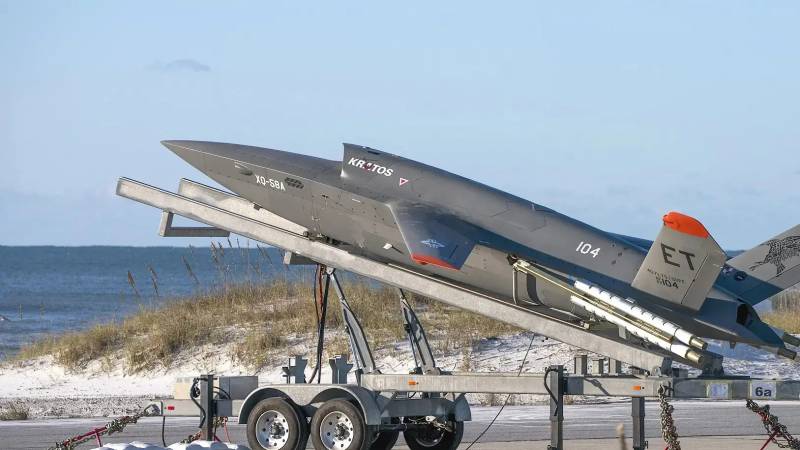
XQ-58 UAV on launcher
Over the past few years, the American company Kratos Unmanned Aerial Systems has been testing the promising XQ-58 Valkyrie unmanned aerial vehicle, and also demonstrating its capabilities to potential customers. The US Air Force is already interested in this product and is carrying out its own testing program. In addition, the Marine Corps, also interested in obtaining UAVs with special capabilities, recently began similar activities.
Drones for the ILC
The USMC is currently planning a major modernization of its combat aviation. In particular, the possibility of strengthening manned aircraft with unmanned combat systems is being considered. For this purpose, the research program PAACK-P (Penetrating Affordable Autonomous Collaborative Killer-Portfolio) is being conducted. As the name implies, its goal is to find a ready-made proposal in the field of combat UAVs capable of operating autonomously or together with manned aircraft.
As part of the PAACK-P program, in January of this year the Naval Air Warfare Center (NAVAIR) ordered two drone XQ-58. With their help, the KMP in the near future planned to conduct full-scale research into the combat use of UAVs and the solution of various tasks by different units of forces.
As recently reported, the first of two UAVs was delivered to the customer in March. A few weeks later, Kratos shipped a second device. Over the next few months, the ILC and related structures prepared for future flight tests and research. This process has only been completed in recent weeks.
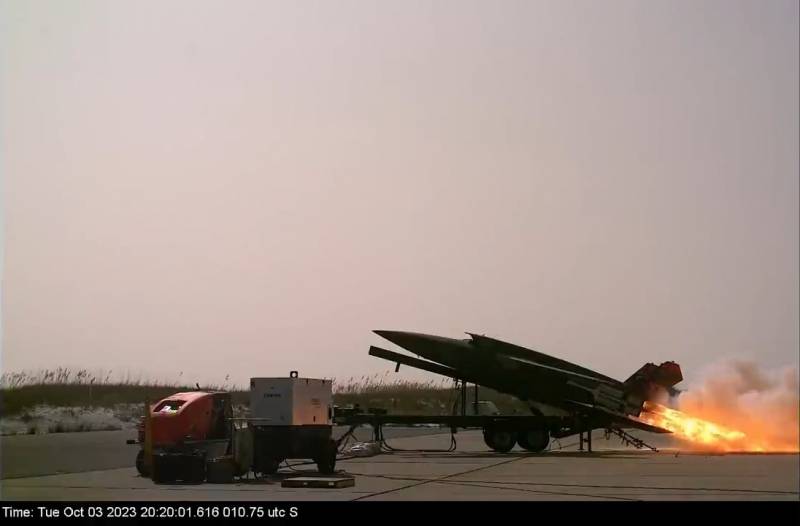
Starting the starting engines
It is curious that even before the start of flight tests, the KMP decided to show off its new equipment and use the Valkyries for advertising purposes. Thus, recently a public event was held at the Miramar base (San Diego, California) with a demonstration of modern Marine Corps equipment. One of the exhibits at the exhibition was the XQ-58 UAV. AIM-120 AMRAAM missiles and a JDAM aerial bomb were displayed next to it. In this way, the exhibition organizers showed the combat capabilities of the drone.
The tests begin
According to the KMP press service, flight tests of the Valkyrie UAV as part of the PAACK-P program have already begun. The events take place at Eglin Air Force Base (Florida) with the participation of corps specialists, structures from NAVAIR and the 40th Test Squadron of the US Air Force. The latter has been working with the XQ-58 since last year and has experience in its operation, which she will have to share with colleagues.
A short video from the first tests has been published, showing the takeoff of the Valkyrie. The UAV launches from a ground-based inclined launch rail and uses solid propellant boosters. Having completed the flight program, the device made a soft landing using the standard parachute system.
The goals and objectives of this flight are not specified. At the same time, Pentagon representatives noted its importance and high significance for the further development of ILC aviation. It is reported that during the flight some data was collected, which is then used to formulate concepts and decisions in the interests of the corps. In the future, the range of research should expand.
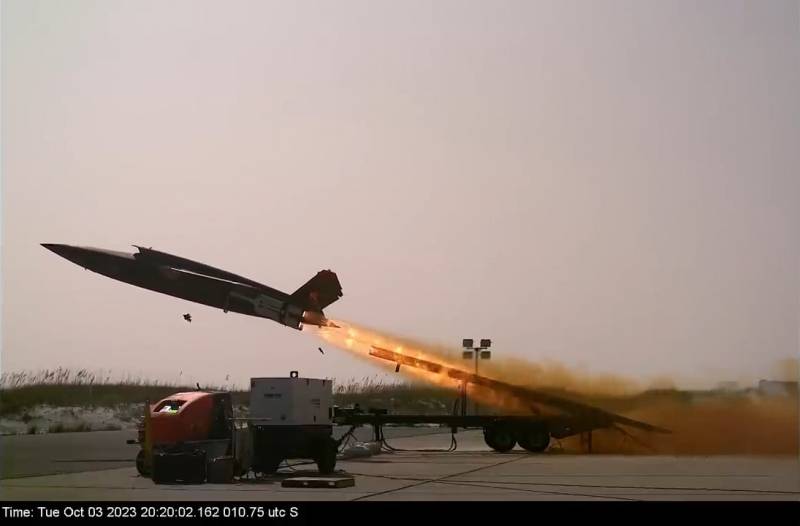
At the moment, it is known that the ILC, NAVAIR and other organizations are planning to conduct at least six test flights. Obviously, we are talking only about the very near future. Full testing and elaboration of all application issues will require much more flights and time.
However, the most general conclusions about the capabilities of the XQ-58 can be drawn after six flights. In addition, the KMP is conducting tests together with other organizations that already have experience with this UAV and could share it. In this case, even joint tests with the simultaneous study of common issues are possible.
Opportunities
KMP reports that the contract with Kratos included the supply of two UAVs as standard. The devices have all the components and means to perform flights and interact with each other or with the operator. However, no payload is installed on them. For now, it is planned to study only the most general issues of using UAVs.
It should be recalled that the development company from the very beginning positioned the XQ-58 product as a multi-purpose air platform with distinctive features and capabilities. It was proposed to develop Valkyries with different payloads to perform certain tasks. The possibility of creating a combat modification, reconnaissance aircraft, electronic warfare UAV, etc. was mentioned.
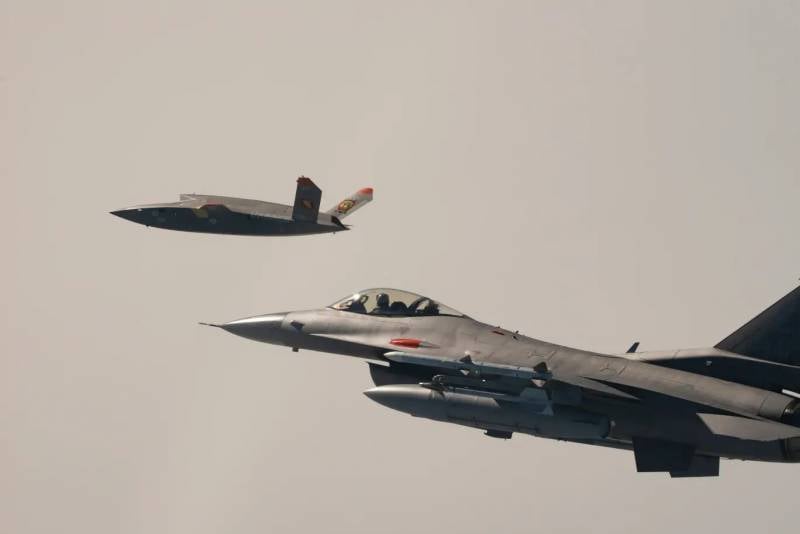
Drone flight accompanied by a fighter jet, October 3, 2023.
On October 5, Aviation Week published interesting statements by the management of the Kratos company. The head of the unmanned aerial division, Steve Fendley, said that several modifications of UAVs for various purposes have already been developed based on the XQ-58 platform. The company representative did not say what options are being discussed, why they might be of interest to the customer, etc.
In addition, development of the original project continues. A modification of the Valkyrie is being developed, designated Block 2B. It will have certain differences from the basic UAV and advantages over it, but the nature of the improvements has not yet been disclosed.
Special interest
It's not hard to see why the XQ-58 Valkyrie UAV from Kratos Unmanned Aerial Systems was of interest to the US Marine Corps. This unmanned aircraft complex has a number of characteristic features that correspond to the specifics of the operation of the ILC and the tasks it solves. Therefore, it was decided to purchase such equipment and conduct tests in order to study its real potential.
In its basic configuration, the XQ-58 is an aircraft-type UAV with a length of approx. 9 m with a swept wing with a span of 8,2 m. The maximum take-off weight does not exceed 2,95 tons. The payload is 270 kg in the internal compartment of the fuselage and the same on the external sling under the wing. The airframe of the device is built taking into account the reduction of radar and thermal signature. In particular, the engine air intake is located above the fuselage and is protected from illumination from the front lower corners. The nozzle is also hidden from observation from the ground.
The UAV starts from an inclined guide using solid propellant boosters. The flight is powered by a single turbojet engine. The cruising speed is stated at 0,72 M, the maximum speed is 0,85 M. Range and flight altitude indicators have not yet been reported.
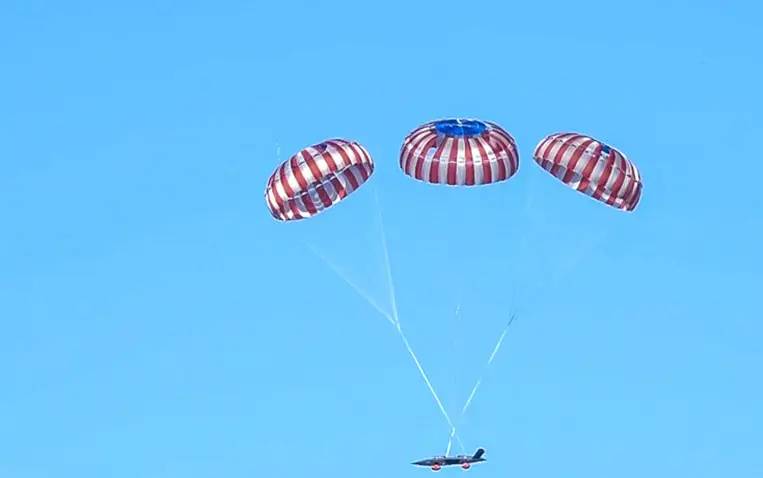
Parachute landing
From the ILC point of view, the advantage of the XQ-58 is its limited size and weight, which simplifies the transportation and deployment of complexes in different theaters, incl. on remote ones. Guided launch and parachute landing should also simplify operation in Marine Corps aviation. UAVs can be deployed on small land sites or on ships.
With all this, the main interest in the Valkyrie is related to its technical and combat potential. It is assumed that such a drone will be able to carry optical and radio reconnaissance equipment or a variety of weapons for working against air and ground targets. He will be able to solve combat missions independently or in groups. Single and group UAVs will be able to operate autonomously or under operator control.
Plans for the future
Thus, the adoption and procurement of UAVs of the XQ-58 type should have a positive impact on the capabilities of USMC aviation. Unmanned systems of this kind will make it possible to quickly create an aviation group of sufficient strength in the required direction, as well as solve reconnaissance and target destruction tasks. At the same time, UAVs will not complement manned aircraft, but will complement it and help it in combat work.
However, the Pentagon is not rushing things and plans to carry out all the necessary research and testing first. A few days ago, the Valrykie product made its first flight in the interests of the ILC. A program for such tests has been drawn up several months in advance, and conclusions will be drawn based on the results of this work. It is likely that the XQ-58 will perform well and will receive a recommendation for adoption.
Information